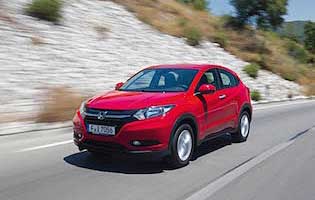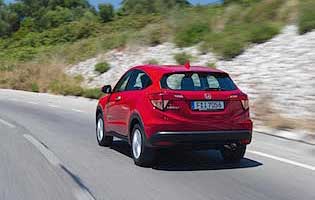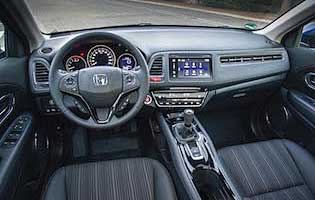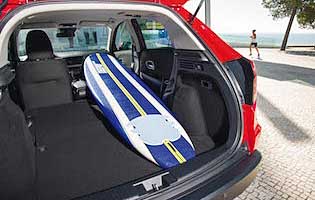



Overall rating

Spacious cabin is refined





Honda is credited as being one of the first car makers to enter what's become known as the crossover market, with its HR-V crossover back in 1998. That car was produced for almost a decade but not replaced – just when the interest in such cars began to increase. The second-generation HR-V hopes to catch up, but joins a fiercely competitive marketplace.
Displaying exterior design cues that will be familiar to CR-V and Civic owners, Honda's second-gen HR-V is clearly one of the family. And it's families that Honda hopes to target with its upmarket compact crossover, by including clever practical features and a focus on safe driver enjoyment.
While this HR-V might not look particularly big despite Honda's desire to compete head-on with the class leaders, the HR-V's Tardis-like cabin easily makes up for any perceived shortfall. The car boasts the ability to carry a three-metre long load, while the Jazz-like rear 'Magic Seats' can be folded up and out of the way as well as flat for maximum versatility.
Honda might have been caught napping in the engine technology department by rivals steaming ahead with greener motors, but the firm is making steady progress. Its 1.6-litre diesel unit a highly regarded performer, and it's paired with an all-new 1.5-litre petrol engine to give low-mileage urban dwellers a lower cost alternative.
The creature comfort and safety kit count is pleasingly high in the HR-V, with the car also gaining auto-brake collision avoidance technology across the board. The trim level-dependent infotainment system's basic offering is par for the course while further up the scale you gain a Garmin-sourced navigation system to complement existing DAB and multiple audio source inputs.
Honda might be late to the compact SUV party but its second-generation HR-V delivers a good blend of premium build quality, thoughtful practical features, ample cabin space and a competent driving experience. Bold looks and a strong engine line-up complete this appealing proposition.
The HR-V isn't being promoted as a budget proposition by Honda, but the firm is keen to stress the frugal and clean nature of its engines. Furthermore, standard kit levels are generous, which should reduce the temptation to dip into the options catalogue. And don't forget to factor in Honda's underlying reputation for reliability and durability.
Deceptively compact, the HR-V is capable of accommodating a three-metre load with the front passenger seat reclined. Its boot space is also a good size and you can, like with the firm's Jazz, fold the rear seat backs down or the seat bases up out of the way to accommodate awkward loads. The cabin also boasts ample oddment storage space and four adults can sit in reasonable comfort.
The HR-V follows a similar approach to cabin design as the CR-V and Civic. Cabin ergonomics are mostly good, although some minor switchgear could be in more obvious locations. Clear main dials are partnered with a less-than-premium infotainment touchscreen. Some features are buried in menus, while the Garmin-sourced navigation function fails to match the premium look of the HR-V's cabin. Thankfully the manual gear shift is short and slick – very sports car-like.
Inside the premium-grade cabin occupants won't be troubled much by external noise sources such as the road or tyre roar. The only disturbance might be from the engines when they're pushed hard, especially the petrol-CVT combination. Elsewhere the car's plush seats make even long journeys comfortable.
Central locking and keyless ignition will no doubt make life easier and safer for owners. Aside from a comprehensive anti-theft package there's also a sturdy-looking load cover for the boot so you can keep valuables out of sight.
The HR-V is equipped with a good range of standard-fit safety kit that you'd expect to see on any premium-grade SUV. Airbags and electronic stability control aside, Honda also offers an auto city brake function to help stop low speed urban collisions, while high-grade models gain a package including traffic sign recognition, lane departure warning plus front and rear facing cameras and a forward collision detection system.
More an all-rounder than an overtly sporty SUV, the HR-V boasts a compliant ride and weighty, accurate steering at speed. Neither engine is particularly powerful, but the diesel's added torque makes acceleration in urban stop-start situations more pleasant. The slick manual gear shift is also preferable to the slower and noisy CVT auto option.
Pitched as a family-friendly car, the HR-V boasts ample cabin space and a flexible load area combined with easy to fold rear seats. The premium grade cabin might be better suited to a more grown up family, while there's no shortage of usable oddment space for all the usual family-related clutter.
Expense aside, the HR-V is an easy car to drive and certainly wouldn't pose any problems in town and when parking. The CVT auto version makes most sense on paper but in reality it can feel sluggish.
Honda enjoys a loyal following thanks in part to its reputation for producing reliable and durable cars. Competition in recent years has intensified, and Honda has sometimes found it hard to keep up in key sectors. The HR-V might be late to market but its many features should help rebuild faith among the fans.
The car's modest raised ride height helps with cabin access, while the rear doors open to a good angle making it easy to get in an out even if you're an adult. The car's tailgate requires little effort to operate and the load lip is a good height for when handling heavy or bulky items.
Key to the HR-V's appeal is a new colour touchscreen infotainment system offering all the usual audio source options: FM, AM and DAB radio, MP3 player inputs and Bluetooth. For Navi-spec cars there's sat-nav provided by Garmin. It's all mostly intuitive but the Garmin nav lacks the finesse of a manufacturer-developed system as it's often slow, can lose satellite signal too easily and the display doesn't match the rest of the cabin instrumentation.
Bold colours help maximise the car's bold exterior design, with red and white both good choices. The HR-V's interior is biased towards a premium ambience, with dark plastics and upholstery dominating the cabin.
Thanks to its compact dimensions the HR-V is an easy car to park. Its light steering and, crucially, lofty driving position help enormously. Parking sensors and, where fitted, reversing camera offer added security in tight spaces.
Emergency tyre repair kit supplied as standard.
Petrol engine options – 1.5-litre (130bhp). Diesel engine options – 1.6-litre (120bhp). Transmission options: six-speed manual gearbox plus CVT auto gearbox (petrol only). Trim levels: S, SE, SE Navi, EX.